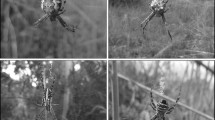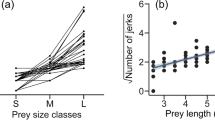A parasitic wasp forces its host to weave a special web for its own ends.
Abstract
On the evening that it will kill its orb-weaving spider host, the larva of the ichneumonid wasp Hymenoepimecis sp. induces the spider to build an otherwise unique ‘cocoon web’ to serve as a durable support for the wasp larva's cocoon. The construction of this cocoon web is highly stereotyped, consisting of many repetitions that are almost identical to the early stages of one subroutine of normal orb weaving, the other components of which are repressed. Here I investigate this activity and show that the mechanism employed by the larva to manipulate the spider's behaviour is fast-acting, apparently chemical, and has long-term effects.

Similar content being viewed by others
References
Eberhard, W. G. J. Hymen. Res. (in the press).
Eberhard, W. G. J. Arachnol. 18, 205–234 (1990).
Tilquin, A. La Toile Géometrique des Araignées (Presses Univ. France, Paris, 1942).
Eberhard, W. G. Evolution 36, 1067–1095 (1982).
Coddington, J. A. in Spiders: Webs, Behavior and Evolution (ed. Shear, W.) 319–363 (Stanford Univ. Press, Palo Alto, CA, 1986).
Witt, P. N., Reed, C. & Peakall, D. B. A Spider's Web (Springer, New York, 1968).
Fincke, O., Higgins, L. & Rojas, E. J. Arachnol. 18, 321– 329 (1990).
Griswold, C. E., Coddington, J. A., Hormiga, G. & Scharff, N. Zool. J. Linn. Soc. 123, 1–99 (1998).
Wenzel, J. W. Annu. Rev. Ecol. Syst. 23, 361–381 (1992).
Holmes, J. C. & Bethel, W. M. in Behavioural Aspects of Parasite Transmission (eds Channing, E. U. & Wright, C. A.) 123– 149 (Academic, London, 1972).
Barnard, C. J. & Behnke, J. M. Parasitism and Host Behaviour (Taylor & Francis, London, 1990).
Toft, C. A., Aeschlimann, A. & Bolis, L. Parasite–Host Associations (Oxford Univ. Press, New York, 1991).
Godfray, H. C. J. Parasitoids: Behavioral and Evolutionary Ecology (Princeton Univ. Press, Princeton, NJ, 1994).
Jenni, L., Molyneux, D. H., Livesey, J. L. & Galun, R. Nature 283, 383–385 ( 1980).
Wickler, W. Z. Tierpsychologie 42, 200–214 (1976).
Author information
Authors and Affiliations
Corresponding author
Rights and permissions
About this article
Cite this article
Eberhard, W. Spider manipulation by a wasp larva. Nature 406, 255–256 (2000). https://doi.org/10.1038/35018636
Issue Date:
DOI: https://doi.org/10.1038/35018636
- Springer Nature Limited
This article is cited by
-
Behavioral Modification of Leucauge mariana Induced by an Ichneumonid Spider-Parasitoid, Hymenoepimecis castilloi, in the Colombian Andes
Neotropical Entomology (2023)
-
DNA metabarcoding of spiders, insects, and springtails for exploring potential linkage between above- and below-ground food webs
Zoological Letters (2018)
-
Polyphagous koinobiosis: the biology and biocontrol potential of a braconid endoparasitoid of exophytic caterpillars
Applied Entomology and Zoology (2018)
-
Parasitised caterpillars suffer reduced predation: potential implications for intra-guild predation
Scientific Reports (2017)
-
Extended spider cognition
Animal Cognition (2017)





